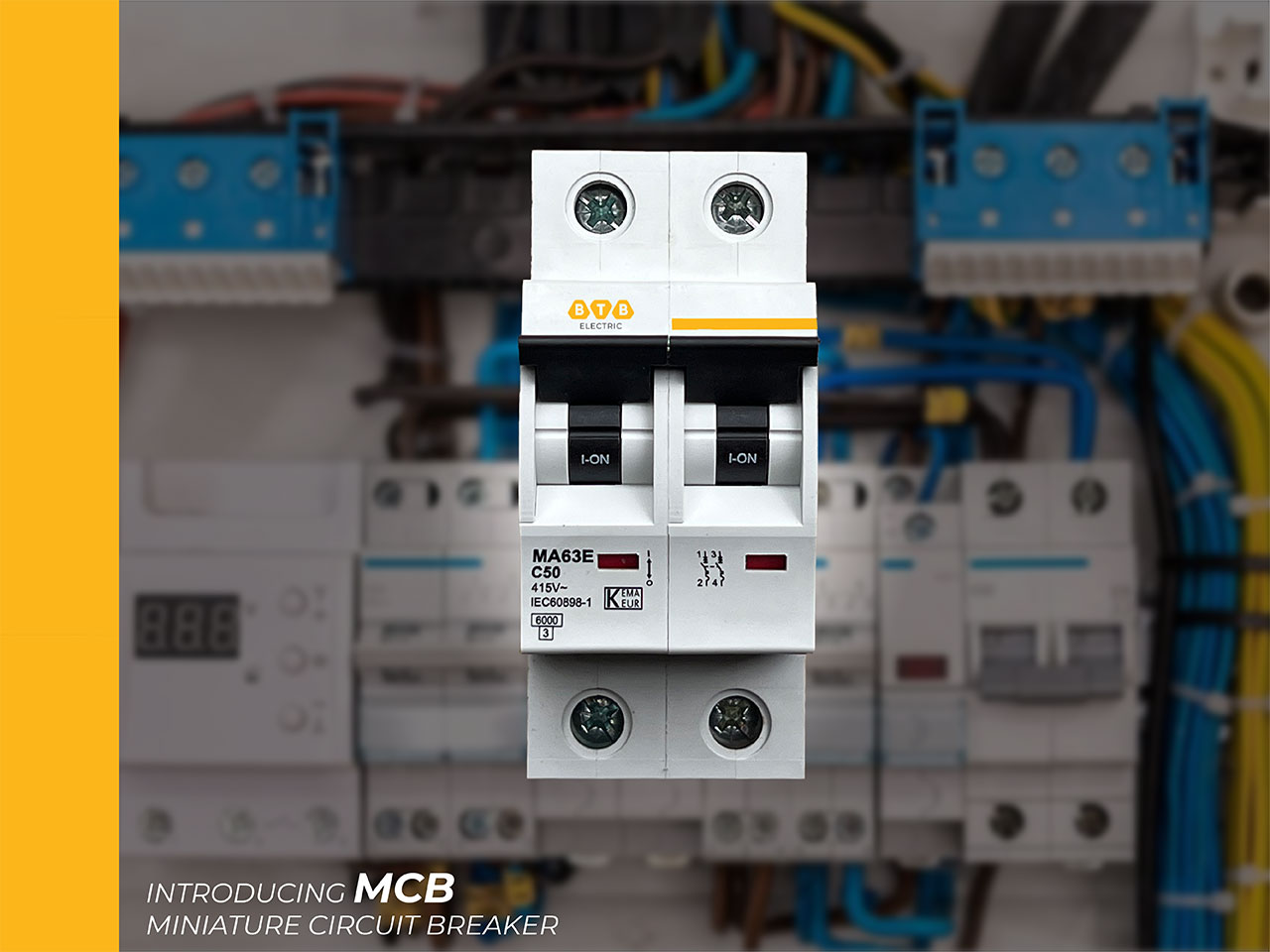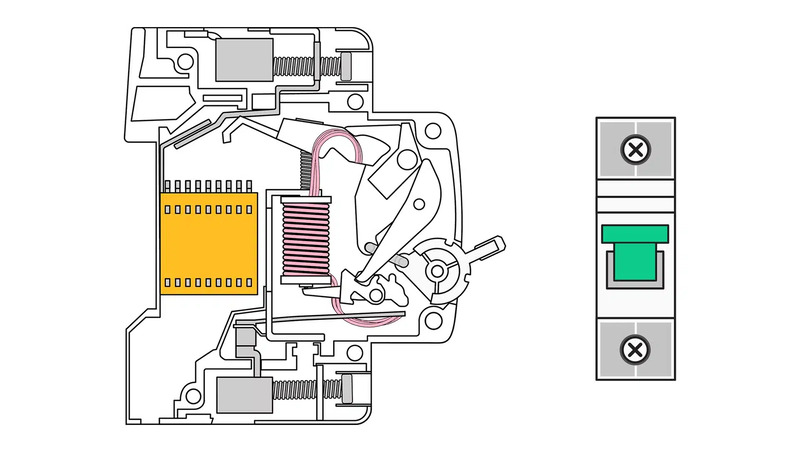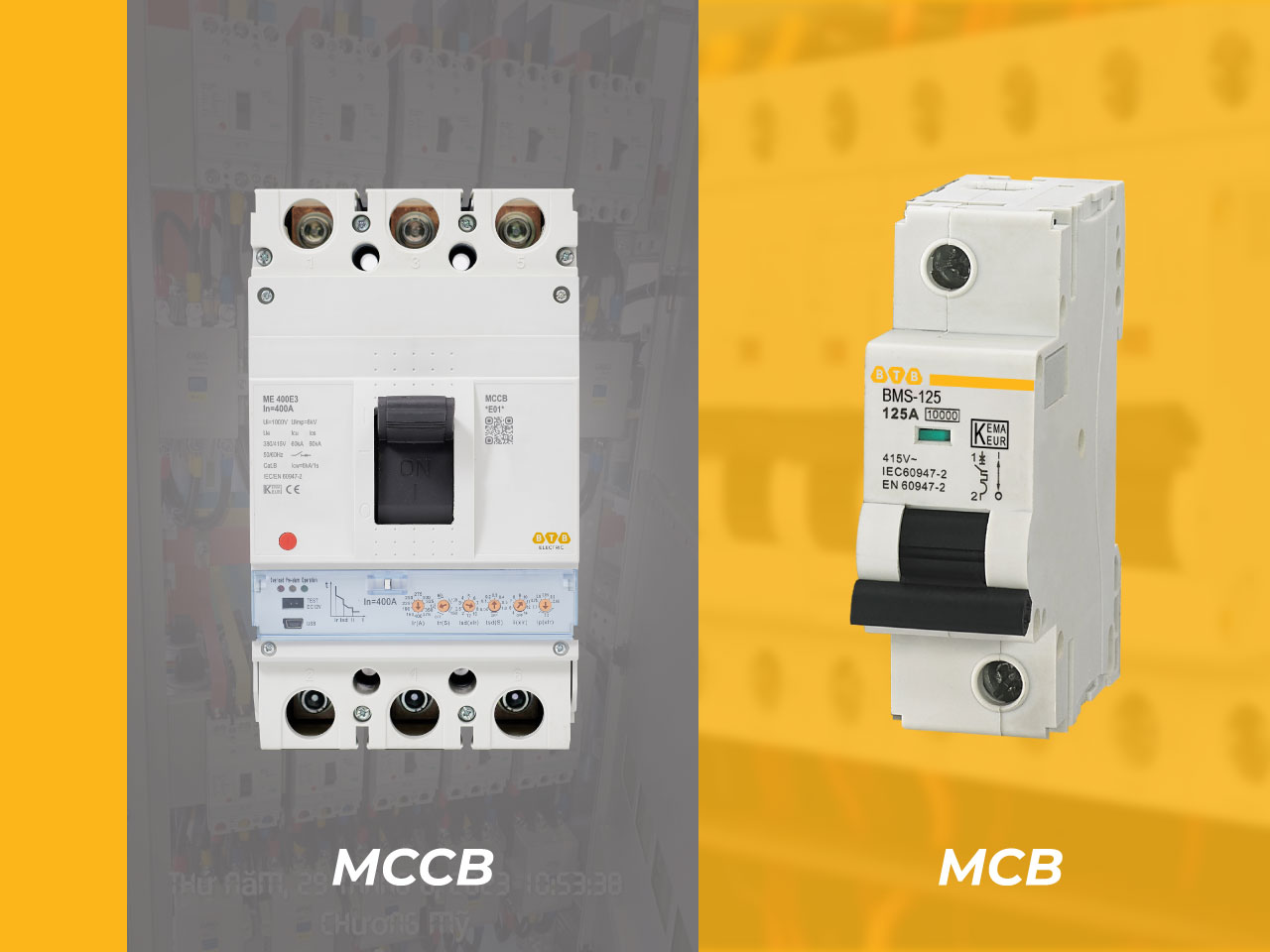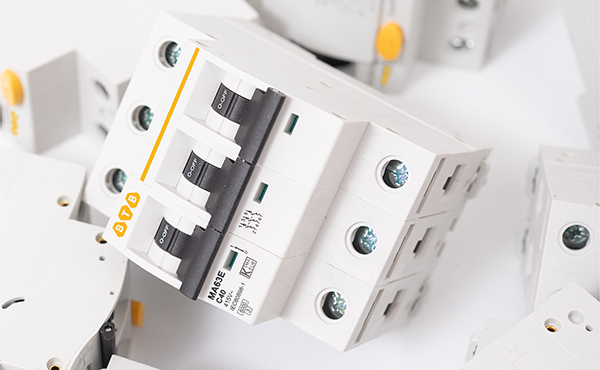Nội dung bài viết
MCB is the most familiar line of circuit breakers in life, especially in homes, gradually replacing old fuses. But many families do not pay attention to this name and often call it shrimp aptomat. So specifically, what kind of circuit is MCB? What are the operating principles and practical applications of MCB? KTH ELECTRIC will give you detailed answers in the following summary article.
What is MCB?
MCB (short for Miniature Circuit Breaker) or mini circuit breaker, circuit breaker is an electrical circuit breaker that has the function of breaking the circuit when detecting an electrical overload or short circuit on the line. MCB is small in size, used for 1-phase and 3-phase power systems with low current levels.
With the ability to be reused many times, MCB has been replacing the traditional circuit breaker position in the home electrical network. Therefore, installing MCB helps users feel secure in using electrical equipment without worrying about short circuits or fires that damage the equipment or affect people. In addition, 3-phase MCB can be used in industrial electrical systems.

Aptomat MCB has many useful features to help protect the electrical system. MCB is designed to automatically interrupt the circuit when an electrical problem such as overload or short circuit occurs. When the voltage exceeds the allowable level, the MCB will disconnect the circuit to protect the electrical system and users. In addition, MCB also helps distribute electricity effectively, ensuring the electrical system operates stably, avoiding overload, energy loss and equipment damage. Another convenient feature of MCB is the ability to identify electrical errors, helping users monitor and control the electrical system easily and accurately.
Structure and operating principle of MCB
MCB structure is typical with the structure of the circuit breaker with 4 main internal parts:
- Contact: MCB usually has two levels of static and dynamic contacts.
- Arc extinguishing box: MCB uses a semi-closed arc extinguishing box placed in the sealed shell of the MCB and has air vents. While the open type is often used with MCCBs with large currents. The arc extinguishing box usually contains many steel plates arranged in a grid to facilitate the arc extinguishing process.
- MCB cutting drive mechanism: There are two MCB cutting drive mechanisms, which are manual drive and electromechanical drive. Manual cutting drives are usually used for MCBs with small rated current, while electromechanical drives are usually applicable for MCBs with larger currents.
- Protection hook: Protection hook has the function of protecting electrical equipment from overload and short circuit. There are two types of protection hooks: electromagnetic hooks and thermal relay hooks. When a problem occurs, the protective hooks will separate and prevent current from flowing through the MCB.

The operating principle of MCB is quite similar to the operating principle of aptomat lines that are resistant to overload and short circuit. When excess current flows through the MCB, the bimetal strip will be heated and bent, resulting in the activation of a spring latch attached to the operating mechanism of the MCB. This mechanical latch opens the contacts, breaking the circuit and preventing further current flow. To restore the current, the MCB needs to be turned back on manually. This mechanism protects the electrical system from errors due to overcurrent or overload.
Details about this principle KTH ELECTRIC has described in the article: What is an aptomat? – Structure, operating principles and applications
Technical specifications of MCB
Some important symbols representing the operating capabilities of MCB are:
- Symbol Ue: Rated voltage of MCB, calculated in Volt (V).
- Symbol Ui: Maximum voltage that MCB can withstand, calculated in Volt (V).
- Uimp symbol: Maximum voltage that MCB can withstand in a polluted environment, calculated in Volt (V).
- Symbol In: Rated current of MCB, in Ampere (A) with a maximum of 125A.
- Symbol Icu: Circuit-breaking capacity of MCB at maximum short-circuit current under normal conditions, calculated in Ampere (A) with a maximum of 10kA
- Symbol Ics: Maximum short-circuit current that the MCB can withstand, calculated in Ampere (A). Normally Ics = 75% – 100% Icu.
- Symbol Icw: Circuit-breaking capacity of MCB at maximum short-circuit current under high temperature conditions, calculated in Ampere (A).
- Symbols C16, C32, C40,…: Corresponding to the rated current In of MCB is 16A, 32A, 40A.
See more in the article: Meaning of parameters and symbols on MCB
Classification of popular MCB lines
MCBs are classified in 3 ways: according to the number of phases, number of poles, according to current intensity and according to characteristic curve.
Classify MCB according to phase number
When classified by phase number, MCB has 4 types: 1P, 2P, 3P and 4P. Specifically, the characteristics of these aptomat lines are:
- MCB 1P: 1-phase 1-pole MCB only connects to the circuit through 1 phase wire, the symbol at the wiring terminal is L, has 1 single lever and is used to protect lighting or sockets in 1-phase electrical systems.
- MCB 2P: 1-phase 2-pole MCB type connected to 1 phase wire and 1 neutral wire, corresponding to 2 L and N poles or 2 phase wiring poles, has 2 single levers and used for 1-phase electrical systems.
- MCB 3P: 3-phase 3-pole MCB type connected to 3 phase wires corresponding to 3 L poles, designed with 3 single levers and used for 3-phase power systems.
- MCB 4P: 3-phase 4-pole MCB connected to 3 phase wires corresponding to 3 L poles and 1 neutral wire corresponding to 1 N pole, has 4 single levers and is used for 3-phase power systems.
Classify MCB according to current intensity
MCB has a wide In current range, from 1A to 125A. Because the MCB circuit breaker is often installed in the home electrical network, the device’s current intensity can be divided according to each usage need:
- MCB 1A to 10A: Used for lights or small power devices such as mist sprayers, radios, heating lamps, etc.
- MCB 12A to 25A: Used for electrical purposes in bathrooms, hallways, worship rooms, storage rooms,…
- MCB 25A to 50A: Used to power living rooms, bedrooms, common rooms, etc.
- MCB 50A or more: Used for floor and whole house electricity.
In most households, MCB 63A is used as a general circuit breaker. The larger current level of the shrimp circuit breaker is used for commercial electricity such as at restaurants, spas, small supermarkets,…
Classification of MCB according to characteristic curve
When classified according to the load characteristic curve, MCBs have the following types:
- Type B MCB: Responds immediately at a rate of 3 – 5 times the rated current. Typically used for small resistive or inductive loads in small surge switching, often in home power systems or small scale production.
- Type C MCB: Responds immediately at a rate of 5 – 10 times the rated current. Typically used for small inductive loads in high-surge switching such as small motors, transformers, and fluorescent lamps.
- Type D MCB: Reacts at a speed of 10 – 20 times the rated current. Often used for high inductive loads, high inrush currents frequently in industrial environments such as large capacity motors, UPS storage stations,…
- Type MA MCB: Responds instantly at up to 12 times rated current, designed to protect motors with high starting currents.
- Type K MCB: Responds instantly at a rate of 10 – 12 times the rated current. Typically used to protect motors with high starting currents and inductive loads.
- Type Z MCB: Responds immediately at a rate of 2 – 3 times the rated current. Designed to be sensitive to short circuit risks and commonly used to protect semiconductor equipment.
Learn more about shunt trip – an accessory of MCB
Application of MCB circuit breaker
Like many other familiar electrical equipment, MCB is an indispensable part of residential, commercial and sometimes even 3-phase industrial power systems. It is not difficult to find MCB on electrical panels in single houses, apartments, offices, agencies or restaurants, hotels, etc. On the other hand, MCB is also used to separately connect important electrical equipment in the house such as air conditioners, induction cookers or water heaters,…

MCB controls the voltage and current in the line. When detecting an overload of current or a short circuit, MCB will automatically disconnect the power source to limit the risk of equipment damage or fire or explosion.
The advantage of MCB is its compatibility with single-phase power and small short-circuit current, from 4.5kA to 10kA, suitable for small capacity electrical equipment. On the other hand, because of its small size, MCB can be easily installed anywhere, not fixed in a central electrical cabinet.
Distinguish MCB from MCCB
Both MCB and MCCB are the two most popular types of circuit breakers in today’s electrical systems and are typical of switching devices used in civil and industrial electrical systems.

The basic differences between these two CB lines are as follows:
- Regarding design: MCB has a compact, separate design, MCCB has a seamless block design. Along with that, MCCB has better insulation and heat resistance due to working with higher current than MCB.
- Regarding operating range: MCB is mainly used for single-phase electricity with a rated current of about 125A or less. MCCB serves 3-phase power systems with rated current up to 1000A.
- Regarding circuit breaker current: MCB’s highest is 10kA while MCCB can reach 100kA and is adjustable.
- Regarding classification: MCB has 1-pole, 2-pole, 3-pole and 4-pole lines but MCCB only has 3-pole and 4-pole lines.
- Regarding control capabilities: MCCB has additional remote control capabilities.
There are also a few differences between MCCB and MCB such as in price, technical specifications, installation capabilities, etc. In general, if used for daily electricity, your choice will be MCB.
Notes when choosing to install MCB
When choosing to install MCB, you will need to keep some of the following factors in mind:
- Select rated current: The rated current on the MCB is always about 15 – 20% higher than the total load current and lower than the load current of the power line. About the calculation formula you can see in the article formula for calculating aptomat selection on the KTH ELECTRIC website.
- Select short-circuit current: This parameter on MCB ranges from 4.5kA to 10kA for residential electricity and from 10kA for industrial electricity.
- Choose MCB type: choose 1-phase, 2-phase type for residential electrical systems and 3-phase type for industrial electrical systems.
- Choose MCB brand: Prioritize CB brands that are well-known in the electricity industry and are rated well for quality.
MCB – Miniature circuit breaker belongs to the circuit breaker product line that KTH ELECTRIC is developing in the Vietnamese market. We are a reputable European manufacturer of industrial electrical equipment with more than 40 years of development. The characteristic of MCB KTH ELECTRIC is its modern shape, the shell is made from flexible plastic with high heat resistance, low water absorption, so it has good dielectric strength.

We provide MCB 1P, 2P, 3P and 4P with rated current from 1A to 125A, meeting the needs of customers with civil and industrial electrical systems. All products are labeled KEMA-KEUR, certified for quality from Dekra, Intertek and Underwriters Laboratory.
Refer to product specifications at: https://btb-electric.com/vi/mcb/
Video introducing MCB 1P – KTH ELECTRIC:
https://www.youtube.com/watch?v=tO3svTPLa0
Video introducing MCB 2P – KTH ELECTRIC:
Video introducing MCB 3P – KTH ELECTRIC:
Some questions about MCB circuit breaker
- Question 1: Is MCB anti-shock?
MCB has anti-overload and anti-short circuit functions, but does not have anti-shock function. If you want to choose an circuit breaker that is similar to MCB and has anti-shock function, choose RCBO.
- Question 2: Where is the installation location of MCB in the house?
Depending on the current intensity and usage needs, determine the location of the MCB. In general, MCB is placed in a centralized electrical panel. MCBs with low and medium current (from 40A or less) are placed in the cascading electrical panel. MCBs with high currents such as 63A are often used as main circuit breakers and placed at the power panel.
- Question 3: Can 2P MCB be wired to neutral?
MCB 2P can optionally connect 2 phase wires or 1 phase wire and 1 neutral wire.
- Question 4: When should MCB 3P and 4P be used?
MCB 3P and 4P are used in 380V 3-phase electrical circuits with low load intensity such as in mechanical workshops, garment factories, pumping stations, etc. In places where 3-phase current has higher current intensity, you should choose MCCB as an aptomat specialized for industrial electricity.


Nội dung được phát triển bởi đội ngũ truonglehongphong.edu.vn với mục đích chia sẻ và tăng trải nghiệm khách hàng. Mọi ý kiến đóng góp xin vui lòng liên hệ tổng đài chăm sóc: 1900 0000 hoặc email: hotro@truonglehongphong.edu.vn